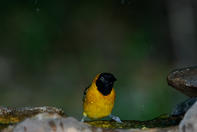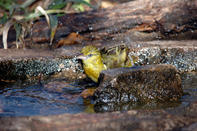Name
Lesser masked-weaver (Ploceus intermedius)Appearance
The male lesser masked-weaver in breeding colours, has a black mask that extends to the centre of the crown and the bill is black. The upper plumage and wings are yellow and black, with the rest of the body being yellow. In non-breeding colours, the male has a yellow head and an olive coloured crown, with grey to yellow plumage.
The wings are yellow and black. The female is almost the same colouring as the non-breeding male. Both birds have yellow to white eyes and blue to grey legs. It is the eye and leg colouring that easily distinguishes this weaver from the southern masked-weaver and the village weaver.
Diet
The lesser masked-weaver is omnivorous and feeds on insects, seeds and nectar. The main insects in their diet are caterpillars, termites and grasshoppers.Lesser Masked-weaver Breeding
The lesser masked-weaver is polygynous (the breeding practise of a male breeding with more than one female at the same time) and colonial. The male will have 2 or 3 breeding females in his territory.
The males build the nests from green strips of reeds, grass or palm leaves and once completed, the nest is a round woven structure. The male will display around the nest to attract the female’s attention. If she accepts the nest, she will line the nest with soft grass, while the male builds a short entrance tunnel.
The female will lay between 2 and 4 eggs and only the female will incubate the eggs for around 13 days. Both parents will feed the chicks with the nesting period being around 15 days. The lesser masked-weaver is one of the smallest birds to host the parasitic Diederik cuckoo eggs.
Behaviour
The male lesser masked-weaver builds all the nests, each nest takes around 9 to 14 hours to build. On average, the male will build between 3 and 5 nests before a female will accept his nest and breed. The nests are only used once. The nests are attached to thin branches and often over water, to discourage predators.Threats
Lesser masked-weavers are preyed upon by African harrier hawks, goshawks and crows.
Distribution and Habitat
The lesser masked-weaver is found in the northern half of South Africa, in the North West, Limpopo and Mpumalanga Provinces, extending down into north-eastern KwaZulu Natal.The lesser masked-weaver is found in savanna woodlands, favouring thornveld, usually close to water.

